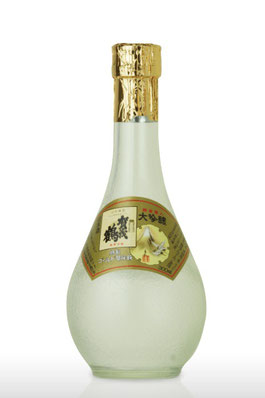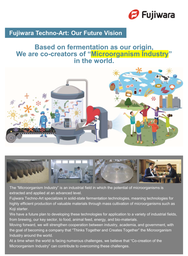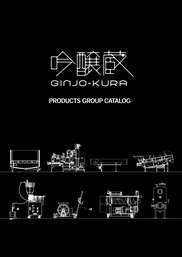- 公式HPリンク
- トータルエンジニアリング
- SAKE Brewery Interview (酒蔵記事)
- 記事制作について
- The Art of Sake Brewing 1
- The Art of Sake Brewing 1(ENG)
- The Art of Sake Brewing 2
- The Art of Sake Brewing 2(ENG)
- The Art of Sake Brewing 3
- The Art of Sake Brewing 3(ENG)
- The Art of Sake Brewing 4
- The Art of Sake Brewing 4(ENG)
- The Art of Sake Brewing 5
- The Art of Sake Brewing 5(ENG)
- The Art of Sake Brewing 6
- The Art of Sake Brewing 6 (ENG)
- The Art of Sake Brewing 7
- The Art of Sake Brewing 7 (ENG)
- 設備デザイン
- 展示会・セミナー
- FTIC(未来技術革新委員会)
- 補助金サポート
- 生産性向上要件証明書
- 微生物インダストリープラットフォーム
- Enz Koji
- 一般食品
- お問い合わせ
The Art of Sake Brewing (vol.2)_English

“Toji (Master Brewer)’s job is to use his five senses”
― Kamotsuru Brewery Co.,Ltd. Chief Master Brewer Kohji Tomoyasu
[Interview Contents]
This article is also available as a Podcast.

Saijo, located in the central area of Hiroshima Prefecture, is known as one of the three famous sake brewing regions in Japan. Surrounded by Kamo mountain range, Saijo area is blessed with the water to brew delicious sake. The well water is used to brew sake, and is also popular as drinking water to quench the thirst of the local people.

In March 2024, we visited the Kura (Brewery) No.4 of Kamotsuru in Saijo. The Kura has been renovated from old style brewery into the modern one, preserving the traditional exterior as registered cultural heritage. Koji Tomoyasu, the Chief Master Brewer of Kamotsuru nicely arranged the tour of the Kura and the area. During the tour we captured his passion for nurturing the next generation and revitalizing the local community.
“Our ancestors must have known Saijo is where the fine water springs up”

If you walk along the Sakagura Street, you can find seven venerable sake breweries. “Our ancestors must have known Saijo is where the fine water springs up”, says Tomoyasu. The spring water from Mt.Ryuoh, one of the mountains of Kamo range, definitely is the key to the quality of sake brewed in Saijo.
The rain falls on Mt.Ryuoh is filtered through granite and reach Saijo after fifteen years. The hardness of the water collected near the halfway up the mountain is about 14mg/L, but it becomes about 60mg/L when it reaches Saijo. That’s the right amount of minerals to brew gentle and smooth sake that characterizes Saijo’s sake. The rainwater flowing into the northern side of Mt.Ryuoh, on the other hand, is used to grow sake rice.

Saijo’s sake, brewed with relatively soft water, is called “onagozake" (feminine sake) in contrast to "otokozake" (masculine sake) brewed in Nada, a famous sake-brewing region in Hyogo Prefecture. However, soft water, which produces a mellow flavor, is difficult to ferment because it contains fewer minerals. It was only after the innovative technique was established that it became possible to brew high-quality sake in Saijo.
Senzaburo Miura, a sake brewer in Akitsu-cho, Higashihiroshima City, invented the "soft water brewing method of traditional Hiroshima brewers" and compiled it in the "Miura Brewing Method" in 1887. Then, Riichi Satake, founder of Satake Corporation, the current top rice-polishing machine manufacturer, developed Japan's first rice polishing machine. It provided the technology to polish rice and improved the quality of Saijo's ginjo sake. The first rice polishing machine was installed at what would later become Kamotsuru.
This is how Saijo's high-quality sake was born, but it didn't gain national recognition until 1894, when the Sanyo Railway (now the JR West Sanyo Main Line) opened. The year after the railway opened, connecting Saijo with major consumer centers such as Osaka and Tokyo, Kamotsuru ran a newspaper advertisement, the first of its kind in the sake brewing industry. The transportation infrastructure and the company's pioneering efforts helped propel Saijo's sake to nationwide fame.
For the local community, with the local community.
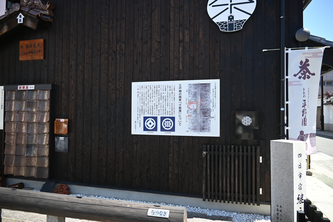
Along the Sakagura Street, there is a public square that tells the history of Saijo. A signboard describes the history of the area that developed around the village headman and the sake brewery. Every October, on the days of the Sake Festival, the square is filled with sake lovers from all over the country.
Before COVID-19, 250,000 people used to visit Saijo over two days. They finally resumed the festival last year and it was a big success. “Recently, we have been seeing a lot of foreign tourists. I want to make Saijo an exciting place, and make the future of Saijo and Hiroshima brighter," says Tomoyasu earnestly. He has a deep connection with the local community. Sometimes he cooperates with his alma mater, Saijo Agricultural High School, and other times he is inspired by the words of the local farmers who produce Yamada Nishiki-the best kind of sake rice.
"When drinking Kamotsuru’s sake, one farmer said, 'The rice we grew has become such a delicious sake. We should work hard to make even better Yamada Nishiki.' His words were so inspiring to me," says Tomoyasu.

Compared to eating rice, sake rice is more difficult to produce. Yamada Nishiki is particularly difficult because it’s tall. Since it’s tall, there is a risk of falling over due to typhoons before the harvest season. With the number of farmers decreasing, Tomoyasu emphasizes that the sake brewers must make sure the farmers can make a profit. "Without Yamada Nishiki farmers, we cannot make sake."
Tomoyasu and the company's commitment to the community is reflected in the fact that 100% of the rice used for their sake is produced in Hiroshima Prefecture. In the past, they had used rice from Hyogo Prefecture, but about eight years ago, they switched to using only Hiroshima rice.
In 2017, they released "Junmai Daiginjo Hiroshima Nishiki." Hiroshima Nishiki is a kind of rice suitable for sake brewing, developed in Hiroshima Prefecture, but it is even taller than Yamad Nishiki. Due to the risk of falling over, it was gradually abandoned. Kamotsuru received just 100 seeds of Hiroshima Nishiki, which had been stored at Kyushu University, and gradually increased the production, and finally brewed a daiginjo sake. "Junmai Daiginjo Hiroshima Nishiki" was released in commemoration of the 100th anniversary of the company's founding.
The timeless flavor of “Gold Kamotsuru”
Kamotsuru polishes all the rice in-house. Tomoyasu says, "If we're going to produce sake under the name ‘Kamotsuru’, we want to be responsible for the quality."
The quality of Kamotsuru is reflected in the flavor of sake. The flavor has been passed down for generations at the brewery. The characteristics is described as "not sweet, not dry, crisp, tasty, and sharp. A perfect balance between sweet and dry."
"You never get tired of the balanced flavor. Sake that you never get tired of is the most delicious sake for me," says Tomoyasu.
"Daiginjo Tokusei Gold Kamotsuru" (hereafter "Gold Kamotsuru"), for example, has a subdued aroma so as it complements dishes with subtle flavors. "It’s been loved for so long because it has maintained a flavor that complements dishes with a perfect balance. Gold Kamotsuru has always been that way, and we must continue to protect the way it is," says Tomoyasu.
While it "enhances" the tase of dishes, Gold Kamotsuru is delicious enough to stand on its own. Usually, daiginjo sake has fruity flavor full of aroma, but some daiginjo have a composed flavor like "tarnished silver" cherished over years. Gold Kamotsuru is the latter. It shines a light on the main dish, but at the same time, it shines itself over time. Gold Kamotsuru is truly a sake that speaks for the breadth of Japanese sake. That’s why Tomoyasu wants to introduce it to people overseas, where only fruity daiginjo is admired.
Kamotsuru Brewery × Fujiwara Techno-Art: Preserving the heritage, moderninzing the Kura No.4
"Gold Kamotsuru" is brewed at the Kura No. 4, which underwent a major renovation in 2018. One of the reasons for the renovation was the shortage of the brewers. The brewers who came to work only during the brewing season were getting older, and the number of brewers was decreasing year by year. Kamotsuru had to maintain the same production volume with fewer people. To overcome the situation, a new production environment was required.
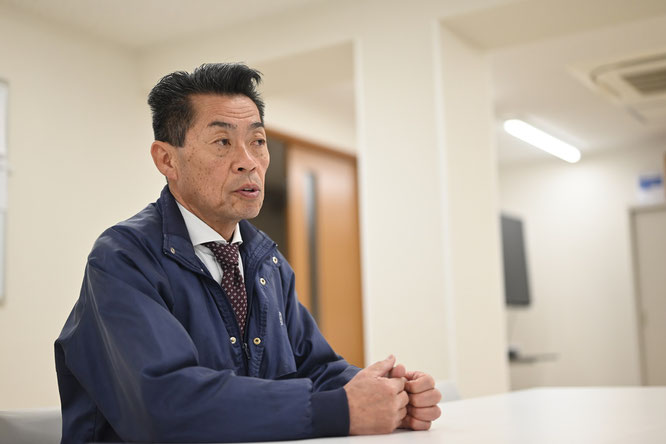
Mr. Tomoyasu talks about the major renovation of Kura No. 4 at that time.
They needed the environment where they can brew sake almost all seasons. They also need to secure vacation time for the brewers. "Even though sake brewing is a rewarding work, it is not necessarily a sustainable work,” says Tomoyasu. “Brewers’ job is hard. We need to make it an attractive job for young people”.
While Tomoyasu was considering how the new environment should be, the Misono Kura, located far from Kamotsuru’s headquarters, was due for equipment renewal. “We should take this opportunity to consolidate all the facilities near the headquarters. Also, we should create the brewery where we can brew various volume of sake, including small volume,” Tomoyasu thought. By consolidating the facilities, it became easier for all operating Kuras to cooperate. “It's rational, and above all, we can say that 'All Kamotsuru sake is made in Saijo area'," says Tomoyasu.
Aiming to create what Tomoyasu called "a facility that meets the updated demands", Fujiwara Techno-Art received the order of plant engineering. While retaining the appearance of the nationally registered tangible cultural property, a clean and effective work environment had to be designed. New equipment, such as a series of “Ginjo-kura” products, “the horizontal rice steamer”, and “the soaking tank with strainer board” were effectively arranged.

preserving the national tangible cultural property.
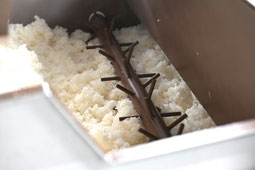
Steel belt type continuous rice steaming equipment
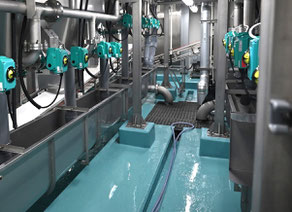
Creating an environment that focuses on hygiene management such as drainage and dehumidification
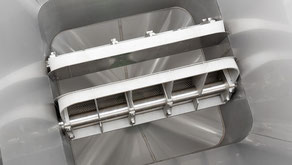
Soaking tank for highly polished rice
(view of plate rotation)
Hygiene was also thoroughly considered.
If you look at the floor in Kura No.4, it is sloped to improve drainage, and gratings in the grooves are eliminated to enhance cleanliness. There are double doors in spaces connected to the outside, and air showers have been installed at the entrances and exits of the facility.
"When selecting the equipment, hygiene and cleanability were one of the major interests," Tomoyasu recalls. "The 'soaking tank with strainer board' is easy to clean because the board rotates in both directions. The inside can be washed thoroughly thanks to the removable drain. It's also full of ingenious ideas, such as a dehumidifier to prevent mold and a design that prevents rice from scattering when it's discharged onto the conveyor."
In terms of performance, "Not only is it fast and efficient at dehydrating, the soaking tank also prevents uneven water absorption. We even soak daiginjo rice polished to 38% in this equipment. Ideally, the rice should be soft enough to crush by hand with the core remaining hard. The strainer board allows us to conduct limited water absorption and make it easier to achieve the target absorption rate."
Question to the young master brewer Nakasuka, “How do you like the new facility?”

Toji. Nakasuka

Adjust soaking time in seconds based on rice condition
We asked the young , at the Kura No.4, “How do you like the new facility?” He answered, "Not only has the overall processing speed increased, but there is also stability and repeatability, which is great. Thanks to the touch panel -not a dial type- you can enter numbers accurately. It is useful to train new people. For example, at what degree the rice should be steamed can be accurately conveyed by numbers, not by intuitions. It is not so much automation, but rather a feeling of 'I have a tool that I can really use.'"
Nakasuka’s words are the proof that he uses the equipment with the profound understanding about the brewing method as well as the machines. Although the touch panel makes it easier to set the number, it is Toji himself who decides the settings. The condition of the rice changes every year, and the temperature of the well water changes with the seasons.
"I steam rice, touch the rice, and adjust the setting if needed. This is where the Toji's experience comes into play. His five senses are essential to determine the optimal settings," says Nakasuka.
Tomoyasu agrees to Nakasuka. "I input settings and analyze data, but the deciding factor is still the five senses. When making koji, I observe, touch, and check the aroma and taste. It's like raising a child. If your child is feeling cold, you cover them with a blanket. If they're hot, you turn on the fan. Toji’s job is to pay attention to koji and notice even a slightest change as quickly as possible."
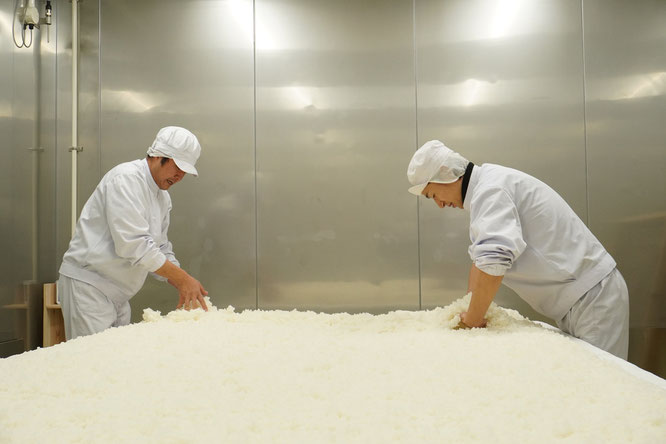
Handmade koji molding in the koji room

Kamotsuru has installed "VEX" for koji making, but also has a “koji room” for handmade brewing. Tomoyasu explains the reason.
"If you want to bring steamed rice into koji room at 30 degrees, it would be too late doing it watching the thermometer. Once you become skilled, you can tell by touch. You don’t need to look at the thermometer. You may be able to make a decent sake with a machine, but I believe that an amazing sake can only be born from the five senses. Koji room is to cultivate brewers’ five senses."
Even when making koji with a machine, Toji touches it with his hands. Toji really is a job that uses the five senses.
“By leaving things to their own hands, young ideas will grow rapidly“
Having finished the major renovation of Kura No. 4, Kamotsuru shift from the old way, that relied on individual veteran brewers who worked without instructions, to the modern and more organized way operated by the full-time employees.
"It turned out to be a good shift," said Tomoyasu. "Thanks to the operation we had established, we could continue making sake without worrying about labor shortages during pandemic. The facility became comfortable environment for the workers, and it became easier to reflect suggestions since we can try brewing small amount at the new facility. The younger generation, including Nakasuka, has been recently breathing new life into Kamotsuru."

Developed in the Challenge Cup
Sake made with roasted malted rice
(* no longer available)
It has been said for a long time that the younger generation is turning away from sake. Tomoyasu admits that there is a demand not only for traditional flavors but also for the sake that suits in this age. But what kind of sake "suits in this age"?
Tomoyasu laughs and says, "I wish I knew the answer to the question. I think ‘trial and error’ is the only way. Young people have flexible minds. They have ideas that turns 1+1 into 3,4,5,…10. What I can do is to create an environment where they can try something new."
In 2021, Tomoyasu organized the Challenge Cup within the company. 6-7 people from across departments were teamed up and tried making their ideas into a product. They thought up and carried out everything from the selection of rice and yeast to brewing methods, package design, and marketing. For the koji production, the koji room was used.
"To take on new challenges, you need the judgement to discern things. To develop the eye for that, handmade brewing experience is essential," Tomoyasu emphasizes.
As a result of the Challenge Cup, sake made by three teams became official products and sold at their store.
"All the sake they made at the Challenge Cup were completely different from sake usually make based on a top-down perspective. By leaving it to their own hands, flexible ideas grow. I want to keep telling them, 'Give it a try.'"
“While inheriting the tradition, you should embrace new ideas and never stop changing according to the situation. Fujiwara Techno-Art has the mindset that I value. That was one of the reasons why I relied on them for our major renovation,” Tomoyasu recalls.
"I visited the company several times and thought that their way of thinking was flexible. They keep things unchanged as a basic principle, but they are not afraid to change according to the situation. Such attitude is shared throughout the company and the young people played an important role in it. I thought that Fujiwara Techno-Art is looking in the same direction as us."
Nurturing the next generation and inheriting the skills.
Protecting tradition, nurturing the next generation, and inheriting the skills---Tomoyasu’s activities go beyond sake brewing.
In 2018, Nakasuka and two other young employees stayed at Fujii Barrel Factory in Sakai City, Osaka Prefecture for three weeks to learn the technique for repairing and maintaining wooden steamers. After that, the third generation of Fujii Barrel Factory, Takeshi Ueshiba and Taizo Fujii, visited Kamotsuru to repair the barrels of the neighboring brewery in Saijo. They also taught the technique to Nakasuka and the other workers. The following year, they stayed at Fujii Barrel Factory again for several weeks to make a large barrel. For the sake brewing 2024, Nakasuka is planning to brew with the traditional kimoto method, using the handmade wooden barrel.
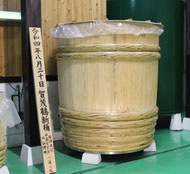
Wooden barrel made by Nakasuka and others

Chief Master Brewer Kohji Tomoyasu
On the day we visited Kamotsuru, Nakasuka was leaving for the local sake fair to decide the sake he submits to the Annual Japan Sake Awards. Tomoyasu sent him off with a smile, saying, "I'm sure he'll ask for my advice when he comes back."
Giving some advice to the young brewer is "just as much of a responsibility as exhibiting my own sake," Tomoyasu says. “I'm an old-fashioned guy," he smiles. “I think it’s my mission to pass on the craftmanship and the traditional skills we’d inherited. We shouldn’t let them disappear.” He was very certain about his mission and the future the young generation creates.
Catalog of equipment featured in this article
Fujiwara Techno-Art develops machinery and plants for about 27 countries around the world, and exports comprehensive technologies including design, manufacturing, installation, and follow-up services. Some of the products introduced in this article have also been exported overseas.
フォームが表示されるまでしばらくお待ち下さい。
恐れ入りますが、しばらくお待ちいただいてもフォームが表示されない場合は、こちらまでお問い合わせください。

